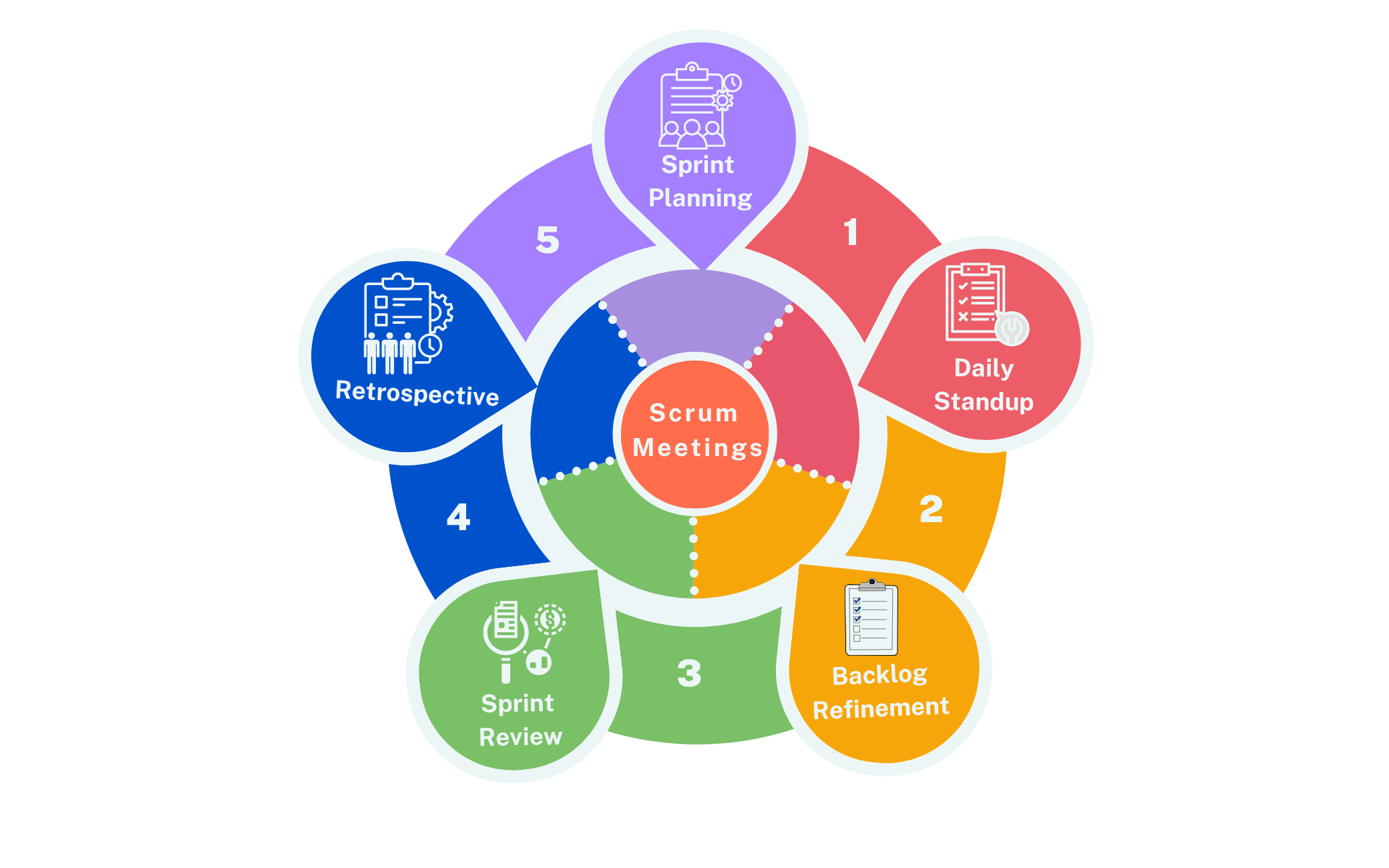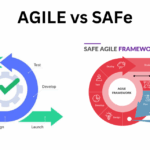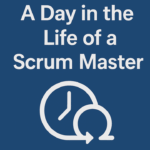Home / Our Blog / Scrum Meetings: The Backbone of Agile Success
Scrum Meetings: The Backbone of Agile Success
Jul 24, 2025 Agile Frameworks
If you’ve ever worked in an Agile environment, chances are you’ve heard the term Scrum meetings tossed around. These meetings are not just calendar fillers, they’re the fuel that keeps your team aligned, focused, and continuously improving. Whether you’re new to Scrum or need a refresher, this guide will walk you through what these meetings are, why they matter, and how to make them work for you.
What are Scrum Meetings?
Scrum meetings, also known as Scrum ceremonies, are time-boxed events that structure the workflow in Agile Scrum methodology. Each meeting has a clear goal, whether it’s planning, progress checking, reviewing, or refining. Together, they keep your team synchronized and your projects moving forward with agility and intent.
5 Agile Scrum Meetings
1. Daily Standup
This quick, 15-minute sync happens every day. Each team member answers three simple questions:
- What did I do yesterday?
- What will I do today?
- Are there any blockers?
The goal isn’t to dive deep, it’s to stay on track and quickly surface issues. Keep it standing to encourage brevity.
2. Sprint Planning
Before any sprint starts, you need a game plan. Sprint Planning sets the tone for the next 1–4 weeks. The team reviews the product backlog, selects tasks for the sprint, and defines a clear sprint goal.
Tip: Make sure everyone understands the why behind each task, it increases motivation and ownership.
3. Sprint Review
Held at the end of the sprint, the Sprint Review is all about showcasing progress. The team demos completed work to stakeholders, gathers feedback, and discusses what’s next.
This is your chance to validate work early and often. Don’t skip it.
4. Sprint Retrospective
Right after the Sprint Review comes the Sprint Retrospective. This is where the team reflects:
- What went well?
- What didn’t?
- What can we improve?
It’s not about blame, it’s about building a better process, one sprint at a time.
5. Backlog Grooming (Product Backlog Refinement)
Although not an official Scrum ceremony, Backlog Grooming is crucial. It’s the ongoing process of refining the product backlog, clarifying items, estimating effort, and prioritizing upcoming work.
Do it regularly to keep your Sprint Planning smooth and focused.
The Benefits of Scrum Meetings
Scrum meetings are meant to be focused, energizing, and productive, not just another Zoom call that could’ve been an email. Here’s how to make them count:
1. Time-Box Every Meeting
Each Scrum meeting has a purpose, and a time limit. Stick to it. Daily standups? 15 minutes. Sprint planning? No more than 2 hours for a two-week sprint. Retros? Cap it at an hour. Respecting time keeps things efficient and shows respect for your team’s focus.
2. Start with a Clear Agenda
Don’t wing it. Even informal meetings need structure. Know what you want to cover and communicate that upfront. When everyone knows the goal, they show up more prepared and focused.
3. Make It a Safe Space
Scrum only works when people feel safe to speak honestly. Encourage open communication. Don’t punish mistakes, learn from them. Your retrospectives, especially, should feel like a judgment-free zone.
4. Keep Discussions Focused
It’s easy to drift off-topic. Appoint a facilitator (Scrum Master or someone else) to keep things on track. Use a parking lot for side conversations and deep dives that can happen later.
5. Make It Visual
Use digital boards or visual tools to keep things clear and engaging. Seeing the backlog, sprint goal, or progress in real-time keeps everyone aligned and helps visual learners stay in the loop.
6. Rotate Roles Occasionally
To keep things fresh and inclusive, let different team members lead standups or retros. It empowers the team and gives everyone ownership over the process.
7. Use Tools That Fit Your Workflow
Don’t rely on scattered spreadsheets or generic apps. Tools like Scrum Slate are built for Agile teams, helping you manage sprints, track blockers, and run efficient ceremonies, all in one place.
The Benefits of Scrum Meetings
Scrum meetings aren’t just a checkbox, they’re the rhythm that keeps Agile teams in sync. When done right, they deliver real value, sprint after sprint.
1. Transparency Across the Team
Scrum meetings keep everyone informed. You always know who’s doing what, what’s blocking progress, and where the project stands. No more guesswork or status silos.
2. Better Collaboration and Communication
With regular touchpoints, team members naturally collaborate more. Daily standups uncover blockers early, planning meetings align priorities, and reviews bring in stakeholder feedback at just the right time.
3. Faster Problem Solving
When blockers are raised daily, they’re resolved faster. This reduces downtime and keeps the sprint velocity consistent.
4. Continuous Improvement
Sprint retrospectives build a culture of reflection. They help your team learn what’s working, spot patterns in challenges, and adapt, so each sprint gets better than the last.
5. Stakeholder Visibility and Engagement
Sprint reviews aren’t just demos, they’re a chance to involve stakeholders. This feedback loop ensures you’re building the right thing, not just building it right.
6. Increased Accountability and Ownership
When everyone commits to the sprint goal and shares daily updates, accountability naturally increases. People take more ownership when they know their progress is visible.
7. Improved Focus and Alignment
Each meeting reinforces your goals. Planning sessions define the “what” and “why,” while daily standups and reviews ensure your team stays aligned and focused through the sprint.
Use Scrum Slate for Effective Scrum Meetings
Want to take your Scrum meetings to the next level? Try Scrum Slate, a purpose-built tool that makes it easier to plan sprints, run standups, review work, and track progress.
With features like automated reminders, backlog management, and real-time collaboration, Scrum Slate keeps your team in sync without the usual meeting chaos.
Scrum meetings aren’t just Agile rituals. They’re powerful tools to drive alignment, speed, and quality. When you do them right, and use the right tools, you set your team up for consistent, measurable success.
Ready to level up your Scrum game? Start running smarter meetings with Scrum Slate.









